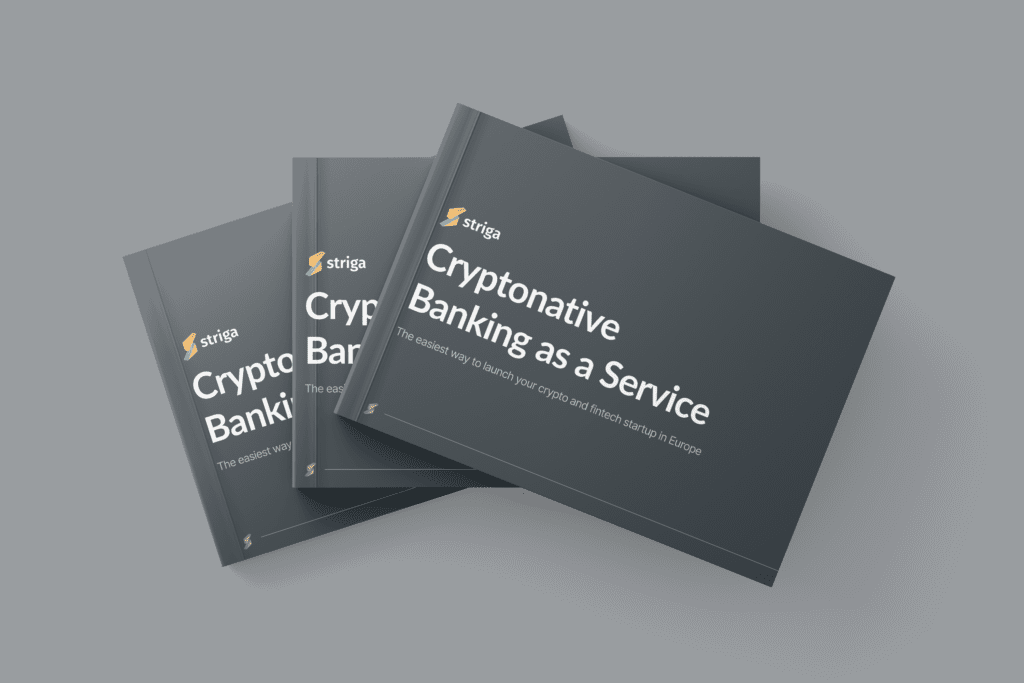How does Striga compare to the embedded finance platform Crassula?
Table of Contents
What is Embedded Finance?
An Embedded Finance provider, per the name, allows other companies to embed financial features into their own applications. They usually cover everything related to cards and bank accounts.
Examples of them are Hubuc and Crassula, though there are many others.
What is Crypto-BaaS?
Crypto banking-as-a-service refers to companies that provide banking infrastructure —usually both crypto & fiat— for other companies to integrate into their own products. Crypto-BaaS usually offer features regarding:
- Crypto wallets
- Crypto exchanges
- vIBAN accounts for individual users
- Virtual and Physical Cards
- KYC & AML controls
Examples of them are Striga, Solid, and Synapse
Where do BaaS and Crypto BaaS overlap?
BaaS and Embedded Finance overlap in card issuing and vIBAN account creation. Basically, as the name implies, Crypto functionalities (wallet, exchange, crypto KYC/AML) are what makes Crypto-BaaS special
Striga Vs. Crassula
Time to Market
Crassula: Based on the public information, it’s not clear how much time the integration with the Crassula platform will take.
Striga takes between 6 weeks and 3 months to fully deploy a product, from the moment you make the decision, through the integrations, until going live.
Striga
Crassula
Time to Market
1.5 – 3 months
N/A
Striga Vs. Crassula:
Financials
Crassula: Crassula platform has not shared its pricing list publicly
Striga: The Crypto-BaaS platform of Striga charges EUR 5,000 as an upfront/integration cost, plus EUR 3,000 monthly.
Financials
Striga
Crassula
Upfront Cost (EUR)
5,000
N/A
Monthly Minimum / Subscription Fee (EUR)
3,000
N/A
Striga Vs. Crassula
Services Offered
Crassula and Striga offer a relatively similar service portfolio. Except for crypto wallets & exchange and white label infrastructure functionalities —which only Striga offers— they both include the following:
- Individual IBAN accounts
- Physical and Virtual Card Issuing
- Apple Pay & Google Pay support (Tokenization)
- Product lifecycle management via a dashboard
Verdict: In terms of services, on the Fiat side, both options are good. If crypto functionalities are desired, Striga is the only way to go.
Services
Striga
Crassula
White Label Infrastructure
Yes
Yes
Individual vIBAN accounts
Yes
Yes
Physical and Virtual Card Issuing
Yes
Yes
Apple Pay & Google Pay support (Tokenization)
Yes
Yes
Product lifecycle management via a dashboard
Yes
Yes
Striga Vs. Crassula:
Technical Setup
Besides the documentation being high-quality, the 4 following elements make the technical setup friendlier:
- Publicly available sandbox: Striga offers a publicly available sandbox. Thus, Crassula, does not offer a publicly available sandbox.
- The number of partners required: Assuming you start from scratch, to go live with a full crypto banking platform, you need the Crassula platform and 2 other partnerships (wallets, exchanges, KYC/AML providers, among others). Striga, on the other hand, is already connected with all the required pieces, so you only need the connection to its platform.
- Interactive setup guide: Though all companies have setup guides, they tend to be static. Striga is the only one with a guide that actually connects to its servers interactively, so clients can test and learn in real time each step of the guide.
- Public API Documentation: Striga has publicly available documentation, as does Crassula.
Verdict: Connecting to Striga requires less effort given the extensive availability of resources it provides, as well as the simplicity of connecting to only one partner, as opposed to 2 on top of the Crassula platform.
Technical Setup
Striga
Crassula
Publicly Available Sandbox
Yes
Yes
Number of Partners Required to Go Live
1
2
Interactive Setup Guide
Yes
No
Public API Documentation
Yes
Yes
Striga Vs. Crassula
Regulation & Compliance
So, integrations were easy to connect, the app has all the features your user’s love, and it is actually making you money due to great financials. The only thing that could put a stop to it is making a regulatory mistake and getting shut down. There are 3 things to know if you want to stay in business: Know your customer (KYC), Anti-money laundering (AML), and Licenses.
- On KYC: Neither Crassula platform nor Striga, allow for KYC outsourcing, they all handle it on behalf of the client.
- On AML: Neither Crassula platform nor Striga, allow for AML outsourcing, they all handle it on behalf of the client.
- On Licenses: Striga does not require its clients to hold virtual asset licenses or commercial registrations. Usually, this is also the case for Crassula platform.
Verdict: In terms of flexibility and regulatory requirements, both options are very similar. It’s a tie
Regulation & Compliance
Striga
Crassula
Outsourceable KYC
No
Yes
Outsourceable AML
No
Yes
Licenses or Commercial Registrations NOT Required
Yes
Yes
Verdict
Is Striga better than the average Crassula?
It really depends on what you are looking for.
If what you want is a fiat-only financial solution that is cheap to start with, then Crassula platform is for you. It is fast and (comparatively) easy to start with them, but they tend to have an inflexible infrastructure and get expensive at high volumes. Still, for new companies, it may make sense to start here.
If, on the other hand, you are interested in building both fiat and crypto infrastructure, and would prefer a more streamlined timeline, then Striga is the solution for you. Striga is ideal for growing companies who want a solution that leaves them space to breathe and expand their operations.
Striga Crypto-native Banking as a Service:
Your path to building and launching financial products
Join the financial businesses that use Striga’s cloud platform to delight their customers and launch their own products without the complexities that come when dealing with core banking solutions’ relationships, licensing, compliance and payments methods.
